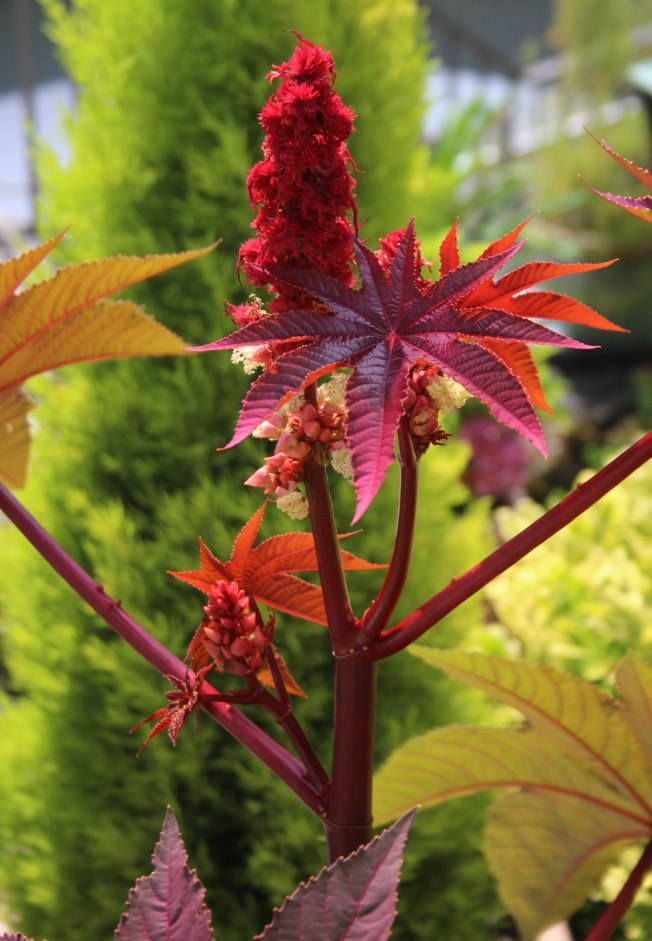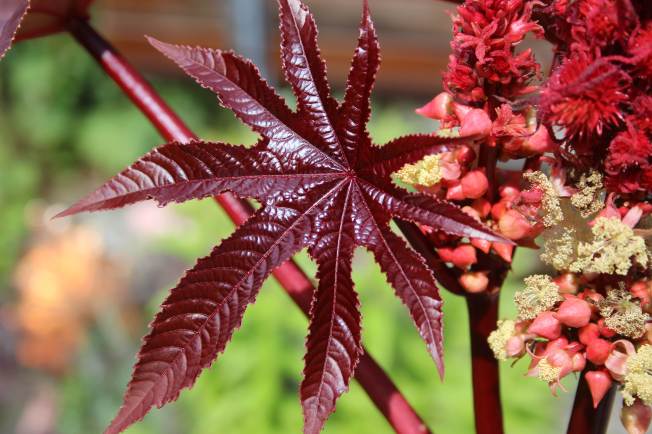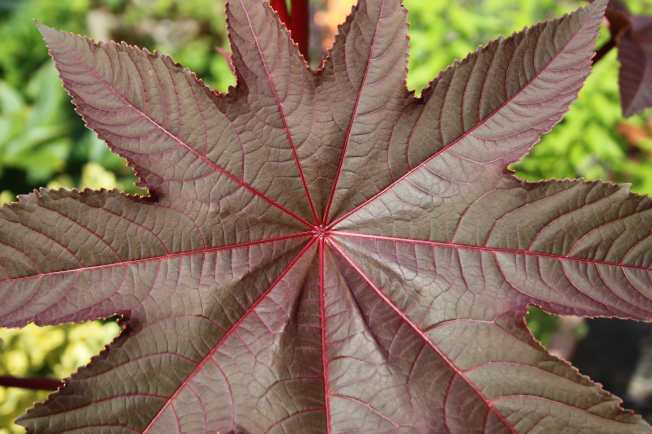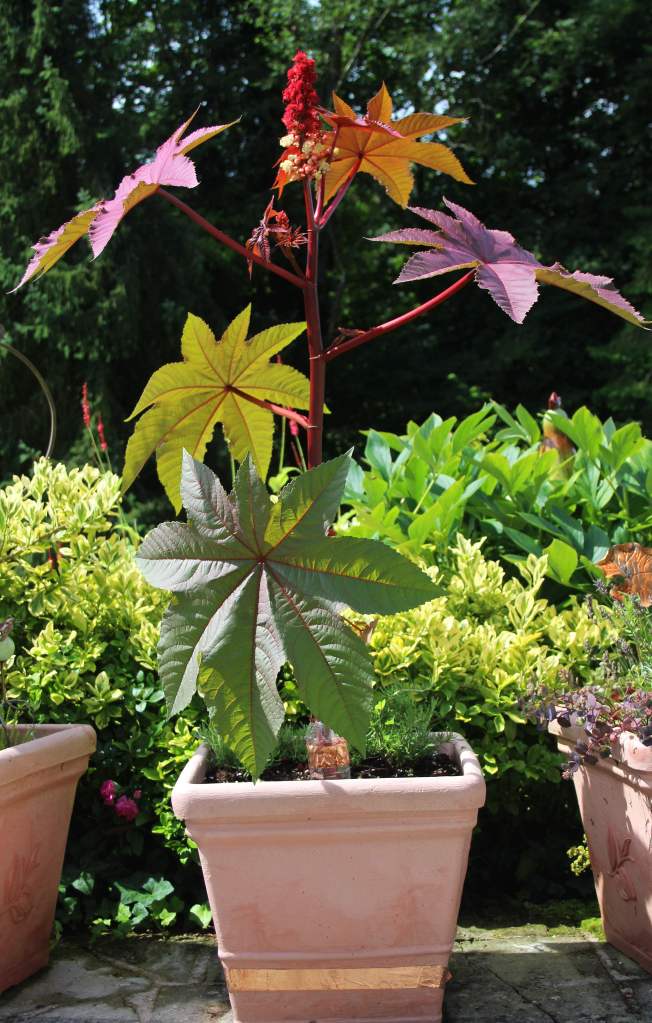Ricinus communis
This tropical plant fascinates me, and after some success a few years ago growing it from seed, I decided to try again this year.
From a packet of nine seeds, eight germinated, one seedling then died, two were planted up in large pots,two are growing in the rockery, and three (also planted in the rockery) were eaten by snails.
The foliage is a beautiful reddish brown when young…
As they mature the leaves turn greener, but still with a predominantly red tinge…
The most fascinating part of it however is the flower and then the seeds…
The flowers are tiny and the seedheads are about the size of a raspberry. But they are not edible. In fact they are very toxic. This plant is also called Castor Bean Plant, as castor oil is extracted from the seed.
The tree actually originates from North Africa, the Mediterranean region and the Middle East, although it is now found in all tropical regions and here it is grown as a summer annual.
In my garden it gets to about 1.5 metres at most, and stands so tall and straight even if in a windy position – quite wonderful. Which is where it gets its German name from I suppose: Wunderbaum (‘Miracle Tree’)!
You can see I have taken precautions against snails, which despite its toxicity are rather fond of this plant. The copper tape around the pot and stem works to some extent, but doesn’t deter them completely. It is supposed to give the creatures a little electric shock as they touch it, but I think my snails are too big to notice it! Some of the lower leaves had to be removed as they were in shreds!
A few more pictures of this weird and wonderful tropical wonder…
Have you ever grown Ricinus? Or any other tropical delight? I am joining Kimberley again today at Cosmos and Cleome, as she asks us to feature something from our gardens each Thursday. Do visit her to see her feature this week, as well as others linking in with interesting plants from near and far!












It’ s stunning. I used to grow it and seeing yours reminds me that I would like to grow it again. Such a dramatic plant. How odd that snails can eat it with impunity. Electric shocks and ricin poisoning- your snails are pretty invincible aren’ t they?
LOL! Yes, we have monster snails as well as incredibly long fat grotesque slugs. I will spare you all the photos though!
Thanks for an interesting post. I have admired this plant even when I have seen it as a ‘road side’ weed in the Mediterranean…and have also enjoyed it when grown as a prize plant in the middle of bedding schemes in gardens in the UK during the summer. The Cypriots must have thought me quite strange going out onto the scrubby areas round the hotel admiring this plant!
I suppose our roadsides must look quite exotic to a Cypriot too! 😉 I first saw these in combination with Cannas as summer planting in a park some years ago and was immediately captivated.
I adore Ricinus communis. Every time I see it, I vow to grow it and then forget. I have just made a note for next year after reading your post. Thank you for the reminder! Like Chloris, I am surprised at the snails.
I would say it is one of the easiest plants I have ever grown from seed, so give it a go Sarah!
I grew castor bean once. Apparently, it is rather toxic, being a spurge. Your specimen is quite striking! It is rather exotic looking, isn’t it?
It does look a bit out of place planted in the rockery, but the two in pots look great as a patio plant. 🙂
I can see why you admire it so much Cathy. Very lovely. Silly slugs.
I watch the slugs and snails all heading home into the undergrowth in the morning and I wonder where they all hide in the hot weather! It would be interesting to see the garden from a snail’s view! 😉
One of my faves and your photos are stunning.
Thanks Ricki! They are hard not to like. 🙂
I adore the castor oil plant foliage but those flowers and seeds are too much for my liking. I have visions of monster snails in your garden.
Yes, we do have monster snails Dorris…. must be something in those leaves that makes them grow! 😉 I know what you mean about the seeds, but they are just so amazing to look at as they grow and develop.
I have grown Ricinus, it is a great addition to any border, you would hope with the seeds being toxic that the slugs would leave them alone!
Our snails are pretty tough and will eat practically anything, unless it has a very stronge smell like sage or lavender. And they are very numerous too. Living next to the woods does have its disadvantages as well as advantages!
Love it!
Your photos are beautiful and I’m glad this plant is doing so well for you.
Mine are ok now as well, but it’s a little insulting to think how they are nearly weeds down south yet can be a struggle to get started for us northern gardeners.
Thanks Frank! Knew you would approve of this one! 😉
That is a really cool plant, and one I’ve often thought about trying out in my garden. You and Frank are going to turn me into a tropical-holic yet! Thanks for joining in, Cathy!
It is great for a patio area, adding a bit of the exotic. I found it so easy to grow from seed, so why not give it a go next spring Kimberley! 😉
I don’t believe I’ve ever seen this plant before, although I have heard of it. It’s stunning! Such a showy plant. It must break your heart when snails get to something this spectacular! It’s kind of funny, but with the drought, we’ve lost our snails! I suppose I don’t miss them, so lack of rain is not all bad. LOL!
I am surprised, as Ricinus must like your climate. Although perhaps they like humidity, and I do give mine water every day. I bet there are some somewhere in your botanical garden! 😉 In dry years we barely see a snail, but this year they have thrived on all the moisture and seem bigger and hungrier than ever! LOL!
I’ve never grown this one, but have seen it in some public gardens. An extremely showy, dramatic plant. Love the color.
It’s nice to add a bit of drama to the garden now and then. 😉
I’ve never heard of a Ricinus. The colors are stunning. It’s nice to hear that it’s quite sturdy as well. I’ve also used copper tape to discourage snails. What I came to realize though, as there willingness to climb up one plant, then dangle down to eat. They’re little acrobats. Now I make sure to use copper at the bottom, then prevent any thing from bridging to the delicious plant. That said, after four years of drought, one of the few pluses is very few snails this year.
Yes, acrobats indeed! I have watched one stretching itself as long as possible to do just that and climb from one leaf to another! Glad you don’t have this problem Alys! 😉
🙂